Grebes are an enchanting feature of our wetland environments, both freshwater and marine. This article focuses on two sometimes confusing species pairs, the large Great Crested and Red-necked Grebes and two 'small grebes': Black-necked and Slavonian.
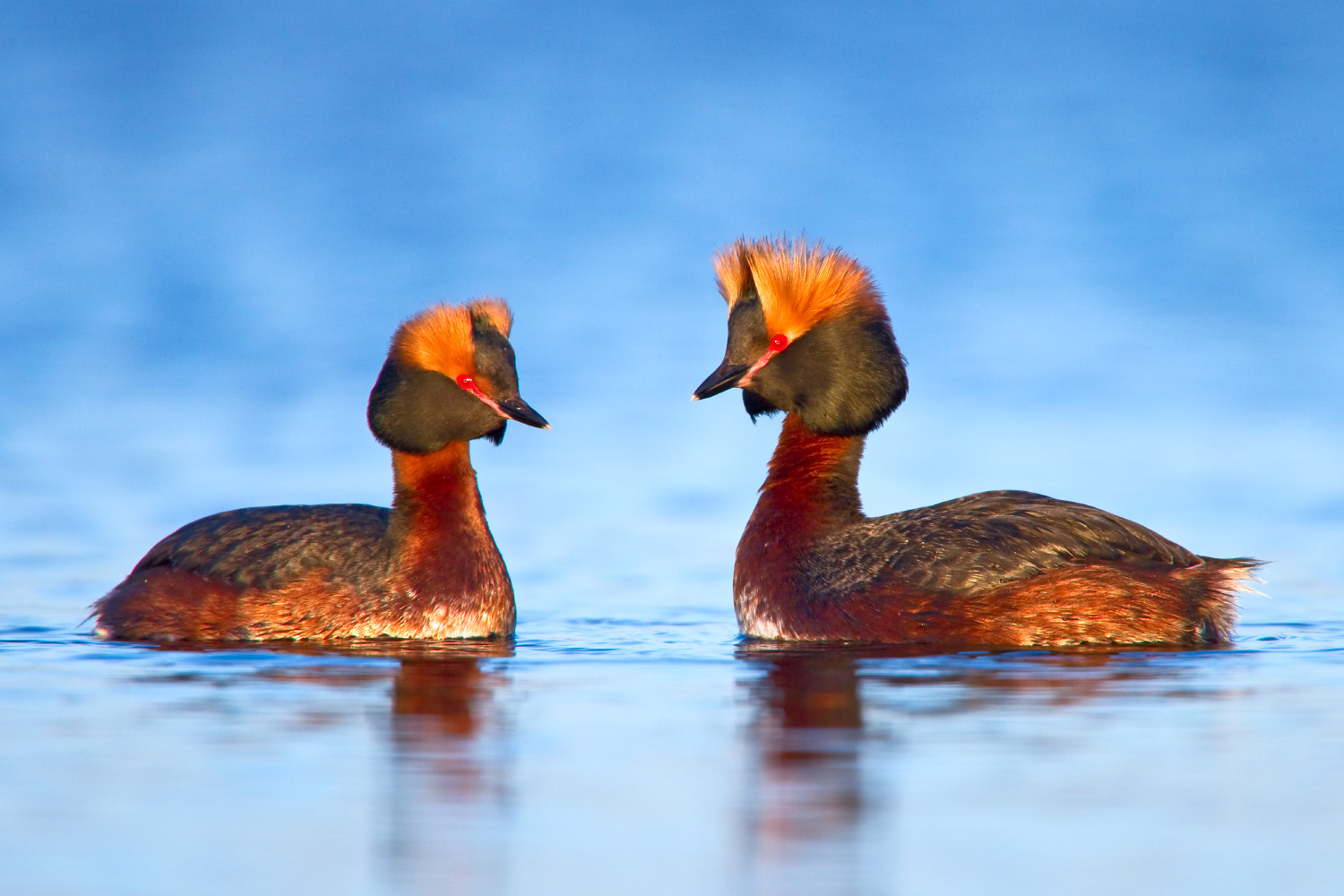
Slavonian Grebe (Lake Myvatn, Iceland, 23 May 2010). All grebes in summer plumage are a delight. These breeding-plumaged Slavonian Grebes are no exception, resplendent in their black and russet feathering, with erect golden head plumes and bright 'redcurrant' eyes. This spectacular plumage is central to equally spectacular display behaviour, as pictured here (Steve Knell).
Great Crested Grebe
This species breeds throughout the Palearctic region, with outlier populations as far away as southern Africa and Australia and New Zealand. This is Britain's most familiar and much-loved grebe, a common breeding bird on lakes, reservoirs, meres and gravel pits across much of the country, but most common in the South and East. Here it delights with its famously attractive head plumes and exotic co-ordinated almost penguin-like dance display. The species winters both inland and on the coast, and there is also some exchange of birds with the Continent. Winter gatherings can be significant and double-figure flocks of this species are not uncommon.
Great Crested Grebe is unmistakable in summer plumage but winter-plumaged birds are more understated. Nevertheless it can be readily identified by its large size, long, low body, angular head profile, long, slim bill, long, thin neck and attenuated, almost snake-like apperance. At range, the white faces and forenecks gleam in the sun, producing an appearance matched by no other grebe. In fact it more closely resembles a winter-plumaged Red-throated Diver than the other grebes. On a closer view, the characteristic white face is obvious, with white extending above the eye and restricting the dark crown. There is a narrow dark loral line and the bill is pink.
Red-necked Grebe
This is a much rarer species in Britain than Great Crested Grebe although it has a large Holarctic distribution. Here it is almost exclusively a winter visitor from the Continent to sheltered waters on the east coast. Occasionally, however, pairs have summered at inland sites and even bred. The winter population is thought to number around 100 birds but very occasional hard weather influxes may send more across the North Sea.
Birds in the gorgeous red-necked and white-faced summer plumage are infrequent in Britain, most here being in winter plumage. These are most easily distinguished at range by their dusky forenecks and dusky faces. Unlike Great Crested Grebe, the dark cap extends down across the face, leaving just a paler throat and a pale area behind the ear coverts. They therefore entirely lack the more startling white-faced appearance of Great Crested Grebe.
Structural differences should be notable too. This is a stockier species than Great Crested: shorter-bodied, thicker-necked, larger-headed and shorter and stouter-billed, lacking the more extreme serpentine proportions of its cousin. At closer range the bill is revealed to be dark with an extensive yellow base.
Black-necked Grebe
This is another widespread species, occurring throughout the Holarctic and also in southern Africa. In parts of its range it is quite common, but in this country it is mainly a scarce winter visitor from continental Europe to shallow, sheltered coastal waters and reservoirs, lakes and gravel pits in the South and South-West. Its winter population is probably around 120 birds. It is, however, also a very rare though regular breeder.
In comparison with the preceding species, Black-necked Grebe is small indeed, not actually much larger than the diminutive Little Grebe and not dissimilar in structure. At range it appears small and frail, small-headed, short-bodied with a fluffy ‘powder puff' rear end, while the head shows a distinctive steep forehead and high rear crown which produces a curiously triangular profile. When relaxed, it can appear neckless but when alert the neck appears surprisingly long and thin.
Its summer plumage is striking, with a black neck, rusty flanks and flaring golden plumes behind the eye, which give it its North American name of 'Eared Grebe'. In winter plumage, though, the species is much drabber, appearing at range a smudgy, dusky grey and white bird with no sharp contrasts. Close-up, this can be seen to be a function of the dark cap which loops down across the face, leaving just a pale throat and a pale area behind the ear coverts. The foreneck is also washed grey, further reducing any plumage contrasts.
Also visible at close range is a short, fine and slightly uptilted bill which, combined with the head profile, produces a highly distinctive look. Very close views reveal a striking bright red eye.
Slavonian Grebe
This other half of the small grebe species pair is also found throughout the Holarctic. In this country it is a scarce breeder in Scotland, with a population of around 60 pairs. These birds winter inshore around Scotland, with a small number of Continental birds wintering in southern and eastern England.
Though broadly similar in size to Black-necked Grebe, this species is structurally rather different with a low, sloping forehead, a flat crown, a short, straight bill and a slightly longer body. The whole effect is therefore slightly less like a Little Grebe and more like a diminutive Great Crested Grebe.
In summer plumage, it resembles Black-necked Grebe with its rusty flanks and golden plumes (which also give it the American name of 'Horned Grebe'), but the foreneck is rusty, not black. In winter the Great Crested Grebe comparison is heightened by the more strongly black-and-white appearance of this species. Unlike Black-necked Grebe, the dark cap only extends down to the eye, where it forms a sharp, straight border with bright white ear coverts. The foreneck is generally white also.
At very close range, a bright red eye, a neat white bill tip and a small pale loral patch may also be visible.
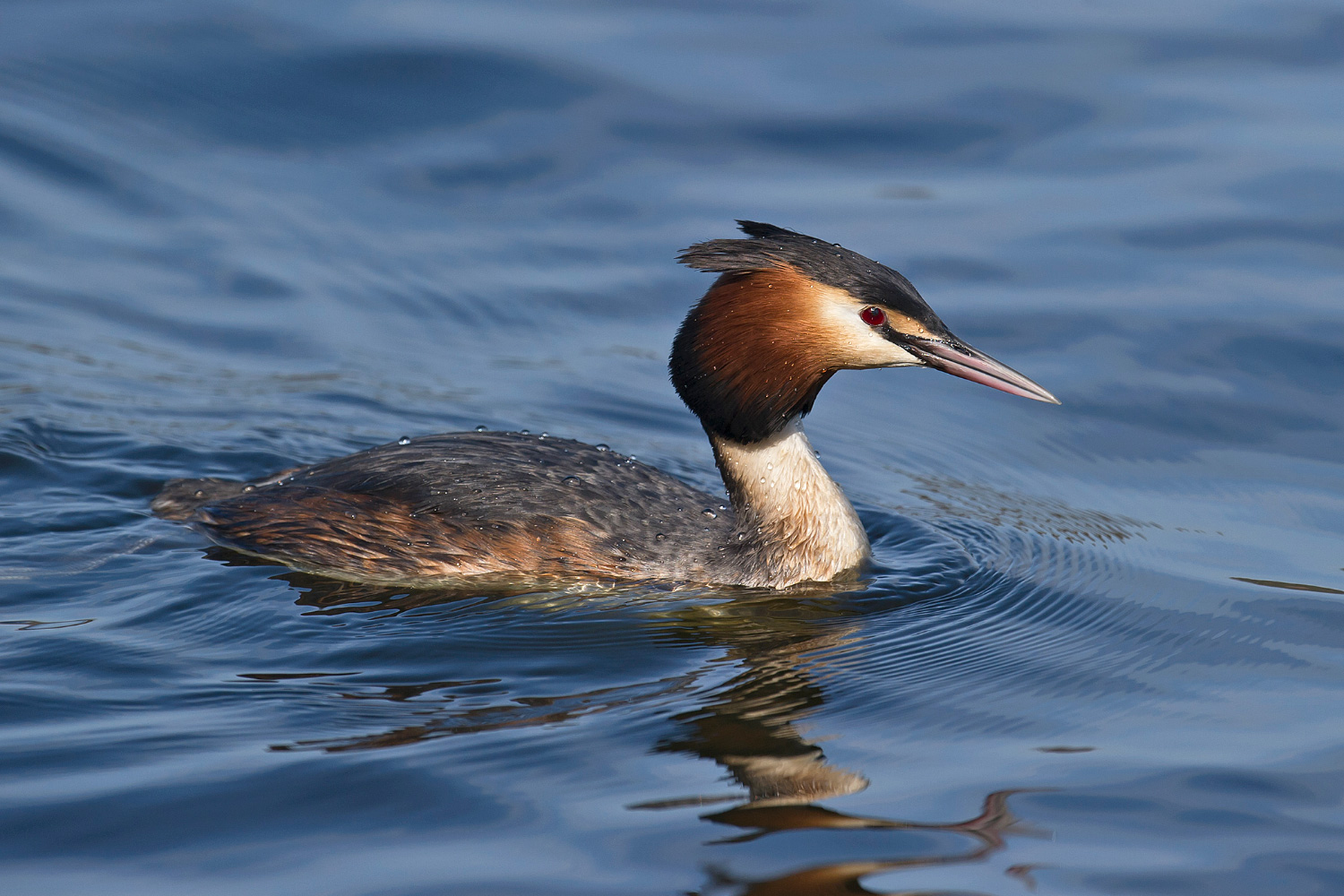
Great Crested Grebe (Carr Mill Dam, Lancashire, 29 March 2012). Great Crested Grebe is unmistakable in its breeding finery. This is our commonest and most familiar grebe, rightly celebrated for its dazzling combination of dark cap, white face (isolating the eye) and elongated orange and black head plumes. At such close range, the dark loral line and pinkish hues in the bill can also be seen. Note also the supremely elegant proportions with a long, slim bill, slim head, long neck and long, smooth body (Steve Young / www.birdsonfilm.com).
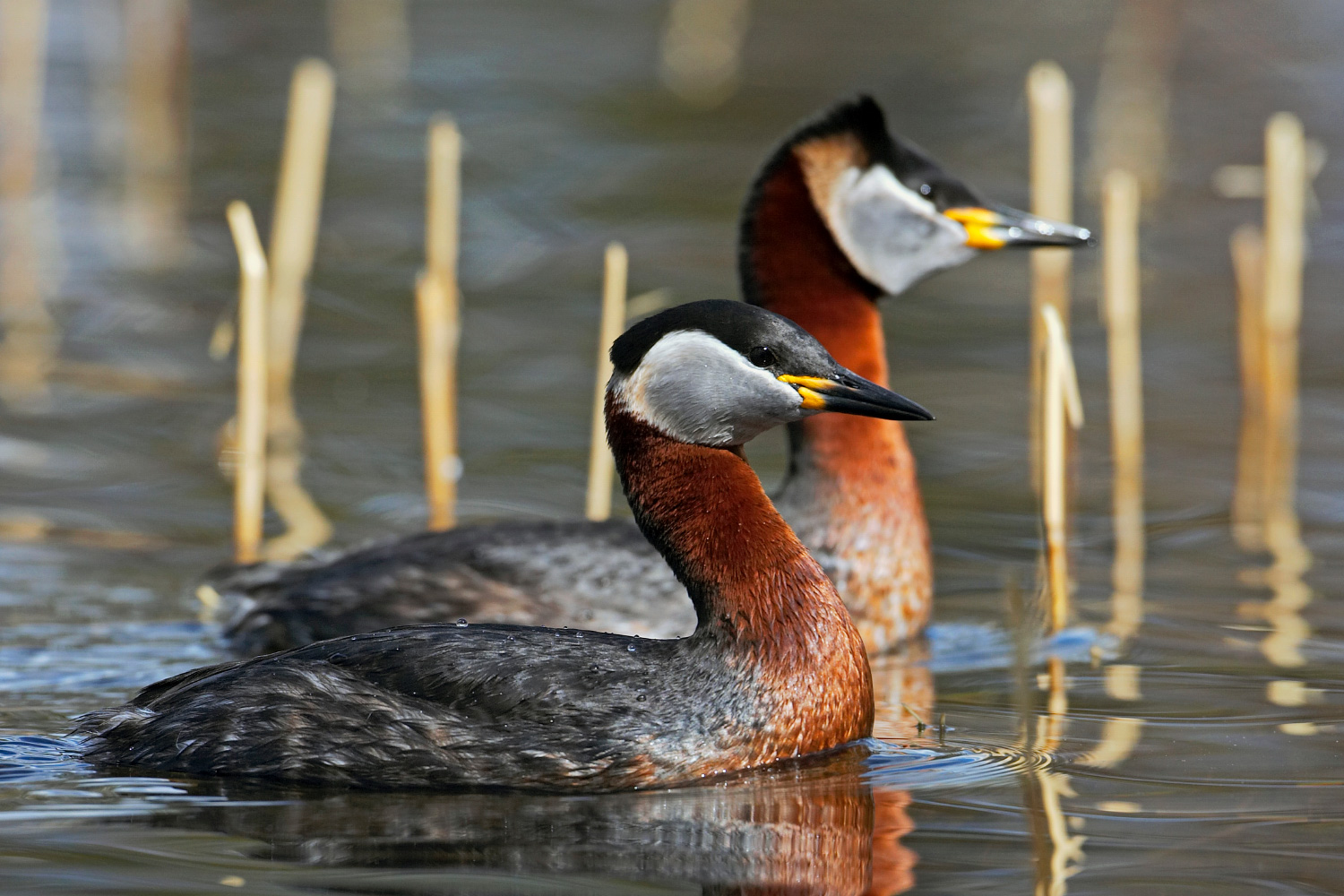
Red-necked Grebe (Ristiina, Finland, 8 May 2005). Summer-plumaged Red-necked Grebes are just as dramatic as their Great Crested cousins, here showing off their deep red forenecks and breasts set off against greyish-white cheeks and a dark cap which extends down to the eye and lores. Also obvious here are small but bright yellow bases to otherwise dark bills. Although a large, elegant grebe, most similar in size to Great Crested, note the more compact proportions – the shorter, stouter bill, the heavier head, the thicker neck and the shorter body (Markus Varesvuo / www.birdphoto.fi).
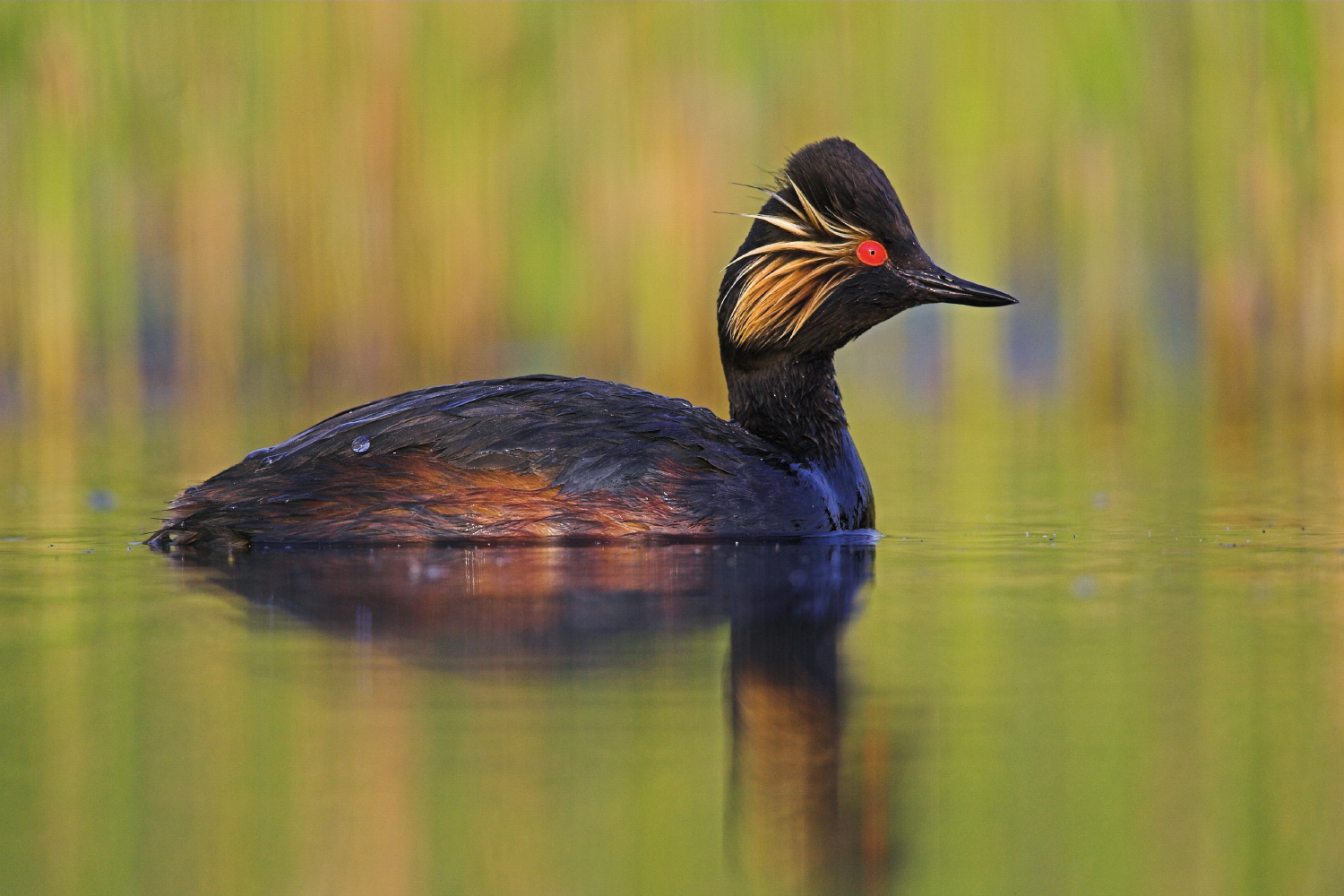
Black-necked Grebe (Meijendel, The Netherlands, 28 April 2008). By contrast with Slavonian, this Black-necked Grebe has a curiously steep forehead and a high, triangular head shape, coupled with a slim, slightly upturned, wholly dark bill. In breeding plumage, as here, it is a striking bird, but note the charcteristic black foreneck, the thinner, more wispy, drooping head plumes and the lack of a pale loral line (Menno van Duijn / www.agami.nl).
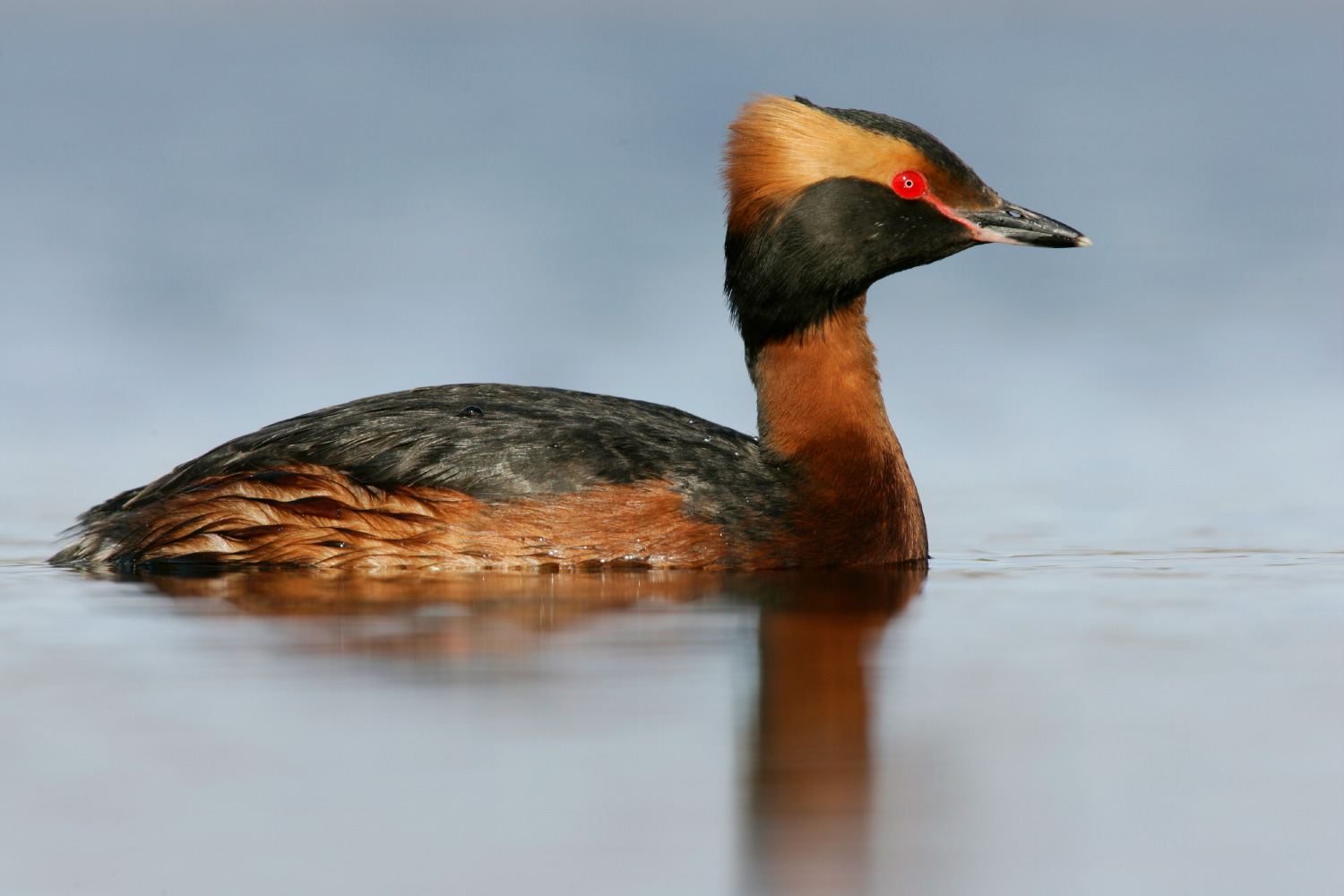
Slavonian Grebe (Iceland, 1 June 2009). This close-up of a breeding Slavonian Grebe shows its gaudy plumage in its full glory. Note the russet foreneck, the quickest way to separate it from Black-necked Grebe, but note also the pale line across the lores. Structural features are useful too, in particular the rather long, low forehead and the short, straight bill. Observe also the small pale tip to the bill, only visible at close range and not shown by Black-necked Grebe (Menno van Duijn / www.agami.nl).
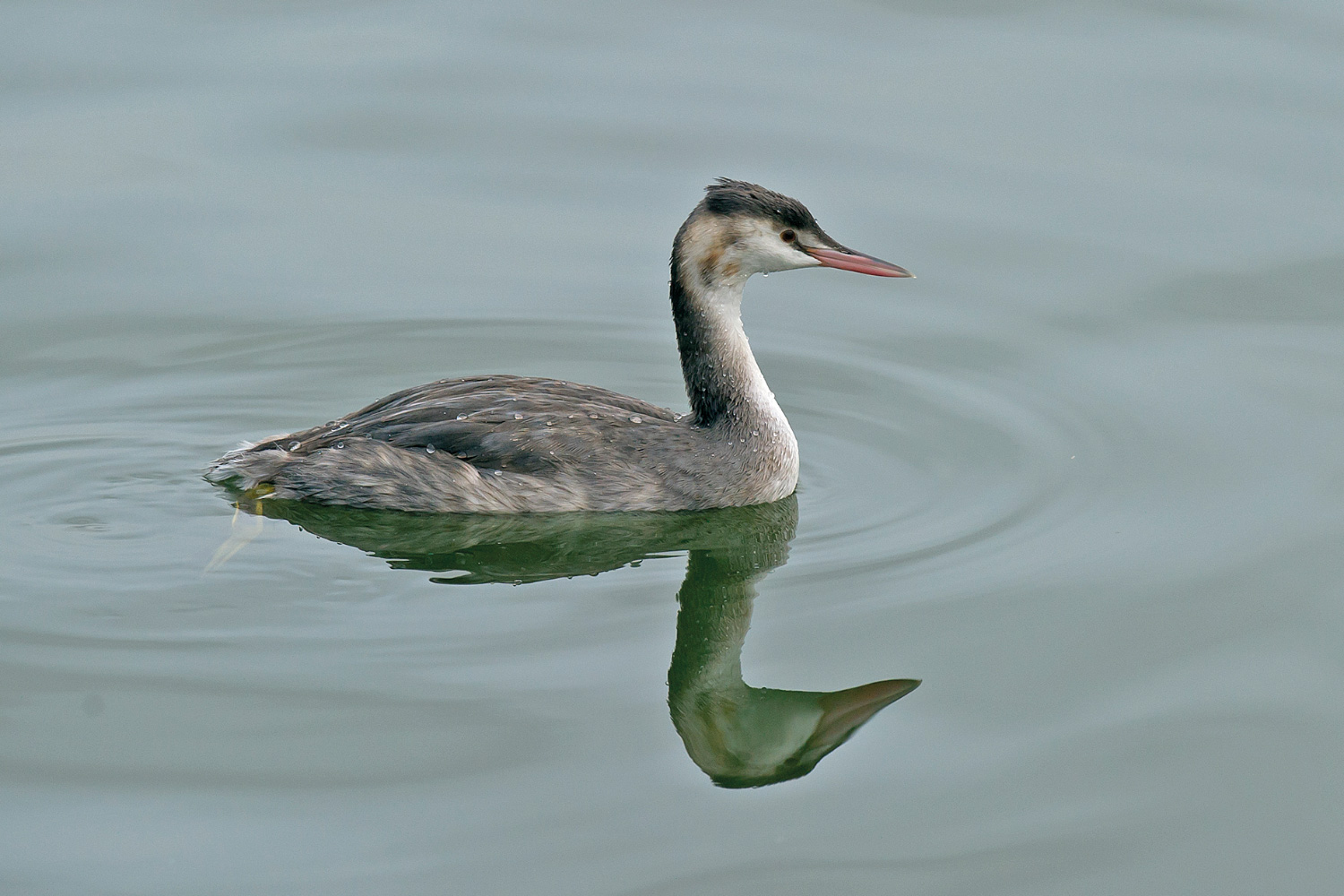
Great Crested Grebe (Preston Dock, Lancashire, 21 November 2010). This non-breeding Great Crested Grebe retains the elegant, almost snake-like proportions but has lost its breeding plumage adornments. In winter this becomes a rather two-tone bird – dark grey above and white on the face (including above the eye), foreneck and underparts. At range the species can appear strikingly white as the sun catches these parts of the plumage, but even in duller light it can often look pale. On this close view it is possible to see the characteristic dark loral line and pinkish bill hues (Steve Young / www.birdsonfilm.com).
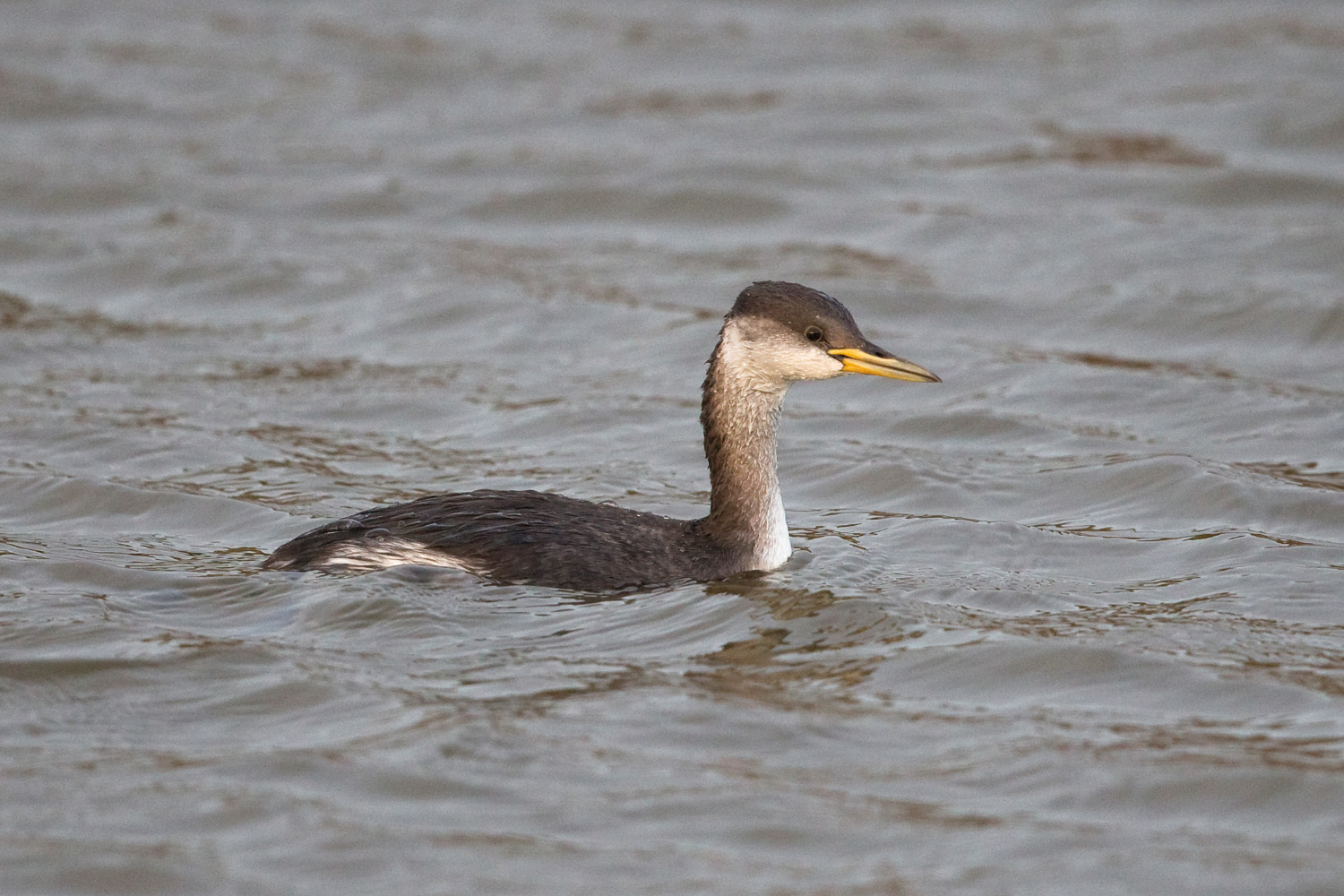
Red-necked Grebe (Blakeney, Norfolk, 4 December 2015). Though a long-necked large grebe, this non-breeding Red-necked Grebe looks very different from Great Crested – shorter bodied, thicker necked, heavier headed and stouter billed. The plumage differs significantly from Great Crested Grebe also, being much drabber and lacking in contrast. It is heavily smudged brown on the foreneck and shows a contrasting whitish cheek (but slightly brown-smudged ear coverts) and a dark cap which extends down across the eye and lores. Note also the yellow, not pink, colours in the bill, the large extent of yellow here indicating a first-winter bird (Robin Chittenden).
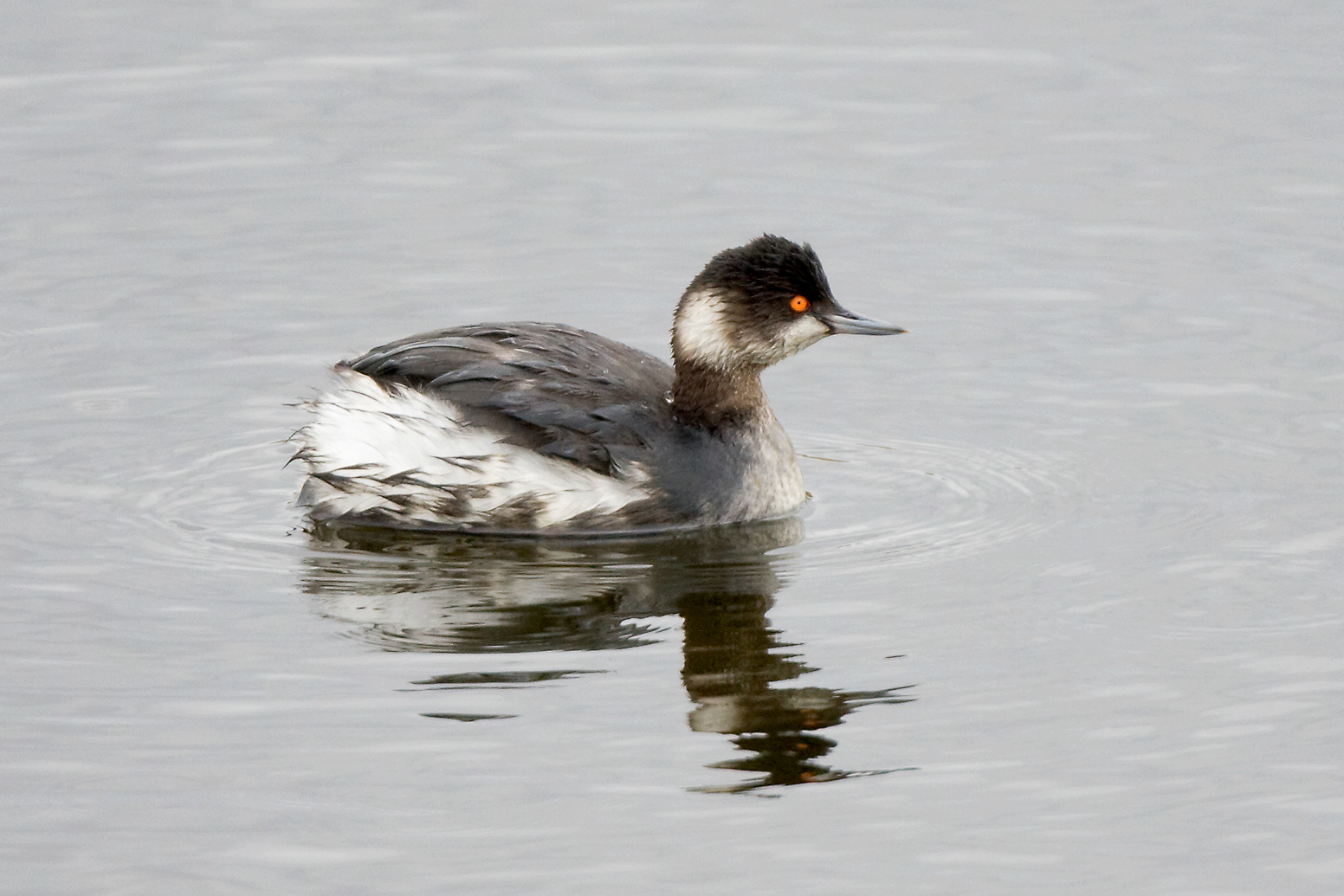
Black-necked Grebe (Titchwell, Norfolk, 22 February 2009). This non-breeding Black-necked Grebe appears rather different from Slavonian. Although a black-and-white small grebe, it looks less contrasty and more drab and dingy than Slavonian. Note also the slim, upturned wholly dark bill and the high crown. Perhaps most striking of all, however, is the 'fuzzy' face pattern, with the grey in the ear coverts reducing any contrasts, white extending up behind the ear coverts and a grey foreneck. Also obvious here is a particularly short body and 'fluffy', 'powder puff' rear end reminiscent of Little Grebe (Alan Tate).
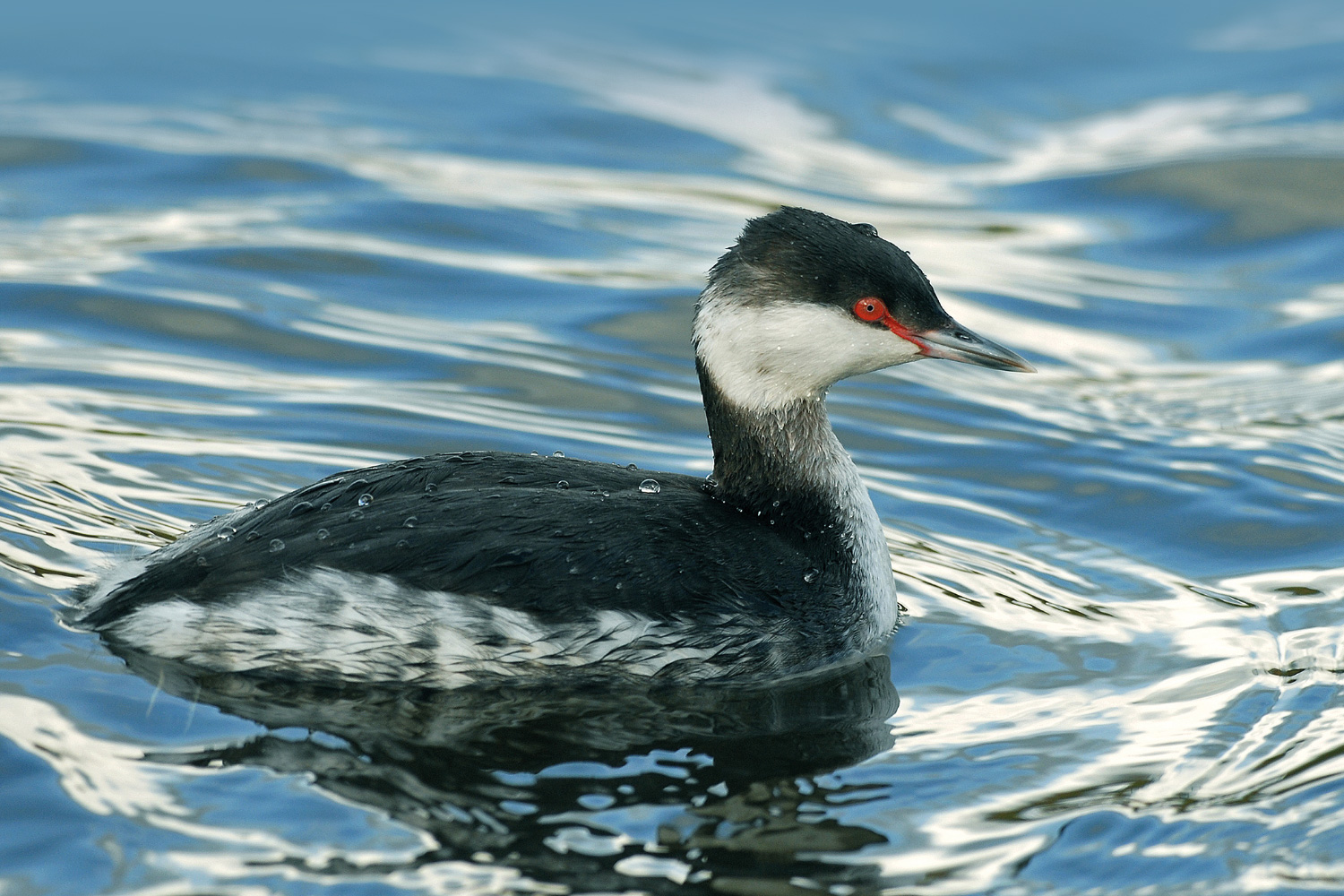
Slavonian Grebe (Clitheroe, Lancashire, 30 January 2008). With its short body and compact proportions, this winter-plumaged grebe is clearly one of the smaller species. On such a good view it is readily identified as a Slavonian Grebe both by its structure – short, straight bill and low, rounded forehead – and by its plumage – a crisp white cheek, neatly delineated from the dark cap, and by its very black and white appearance. Note also the just-visible pale bill tip, a reliable character at close range (Steve Young / www.birdsonfilm.com).
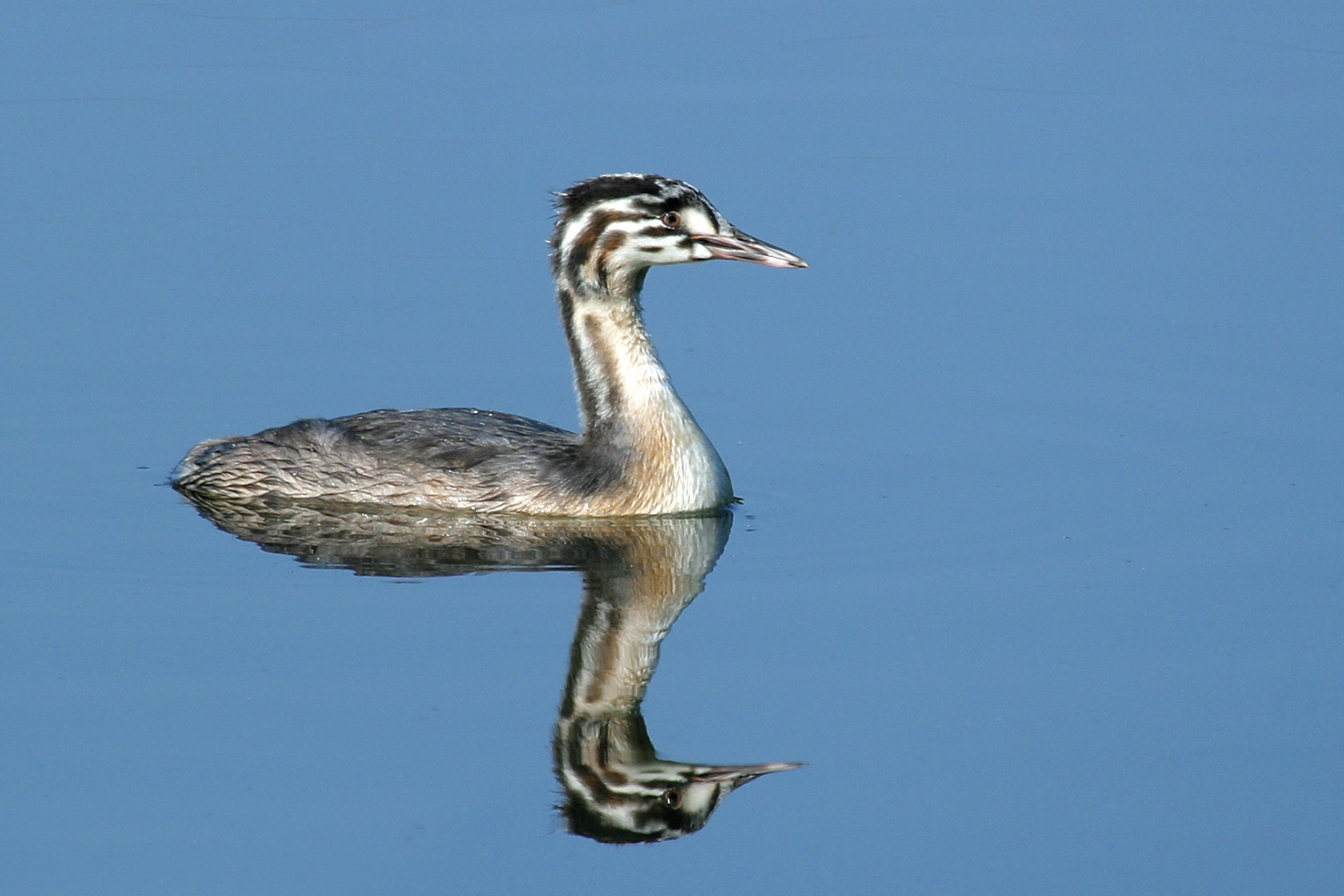
Great Crested Grebe (Stover Park, Devon, 15 June 2003). This Great Crested Grebe is in juvenile plumage. Birds of this age are striking indeed and easily identified, not least because they may well still be accompanied by their parents. The pattern of dark brown stripes on the head is difficult to describe but highly distinctive nonetheless. Although a very young bird, the slender proportions, long body and neck, slim head and long, slim bill of this species are already evident (Howard Bottrell).
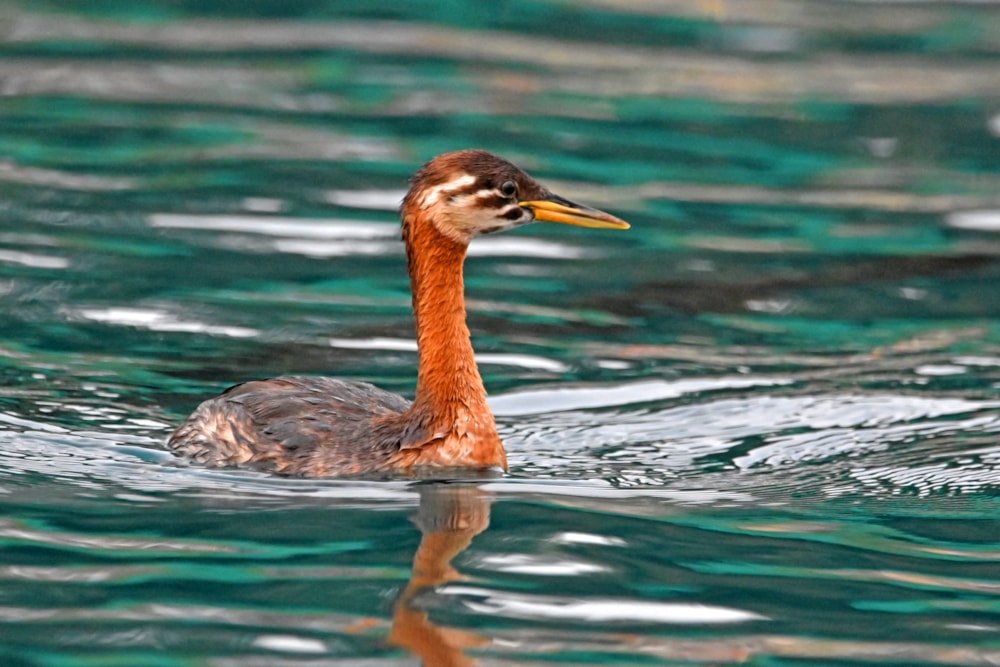
Red-necked Grebe (Vabriga, Croatia, 22 September 2018). This young Red-necked Grebe still has its juvenile face stripes and also a reddish neck, but it will soon acquire first-winter plumage comprising a whitish cheek below a dark cap which extends down to the eye and across the lores, and a dusky brown foreneck. The extensive yellow hues in the bill are typical of a young bird – the yellow bill base becomes more restricted in adult plumage. Note also the classic structural features of this species – a stocky body, thick neck, heavy head and stout bill (Neil Loverock).
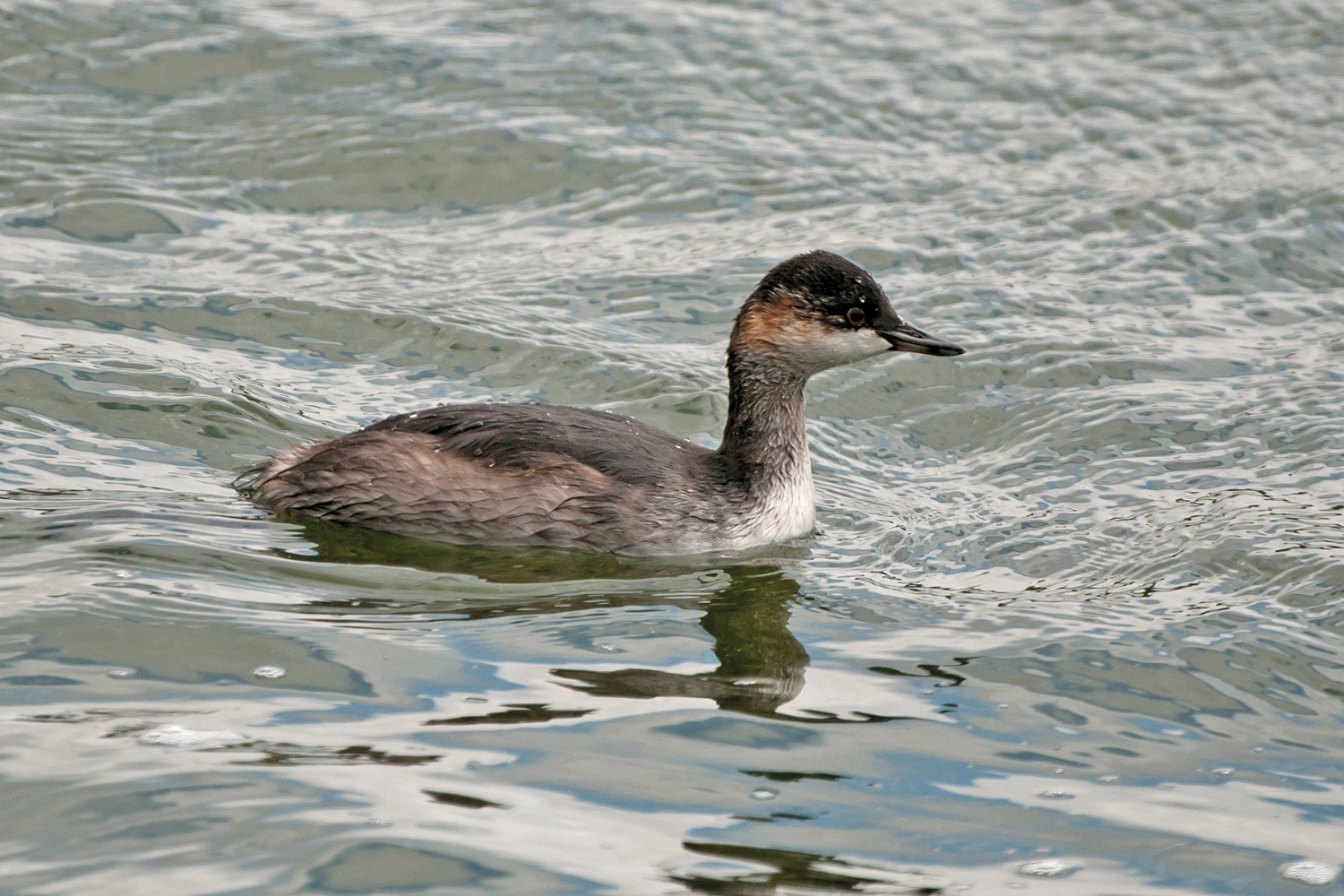
Black-necked Grebe (Seaforth, Lancashire, 7 July 2008). This young Black-necked Grebe shows a characteristic rusty wash on the ear coverts, rather different from the comparable plumage of Slavonian Grebe. Note that this orange colouration is not the remnant of an adult summer plumage. The rest of its plumage differs little from that of an adult (although, typically, it is browner bodied) and it can be identified by its smudgy grey foreneck and dull ear coverts which reduce the cheek/cap contrast. Structural features are evident too, notably the short, rounded 'fluffy' body, the slim, upturned bill and the high triangular head shape (Steve Young / www.birdsonfilm.com).
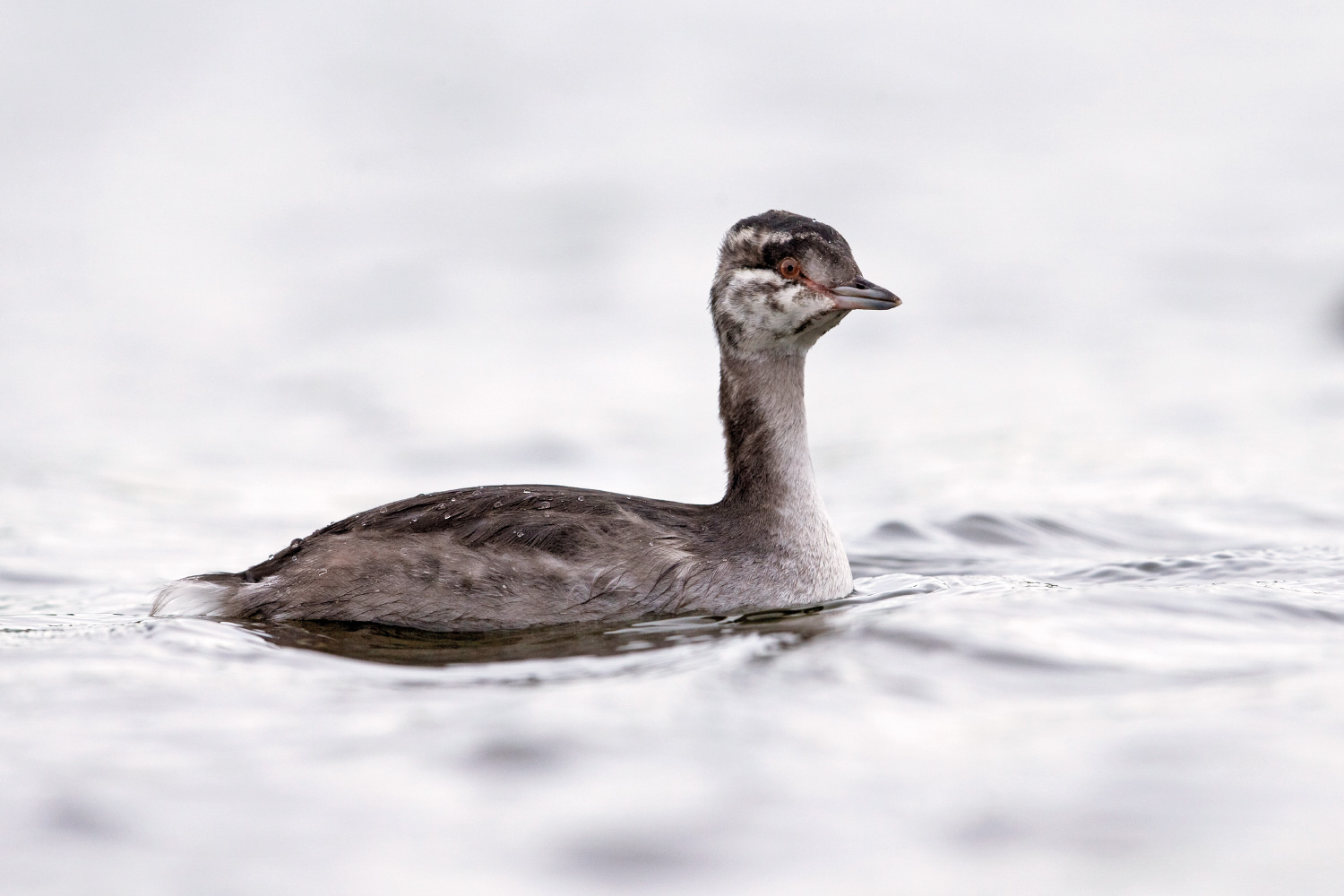
Slavonian Grebe (Húsavík, Iceland, 16 August 2016). Downy young Slavonian Grebe shows a rather complicated black and white face pattern but this is soon moulted out and, in Britain, only likely to be encountered at breeding sites. This Icelandic bird is moulting into its first full juvenile plumage but it already shows the typical low, rounded forehead and short, straight bill of the species; size and structure, as well as plumage, are good pointers to separating the two smaller grebes (Robin Chittenden).
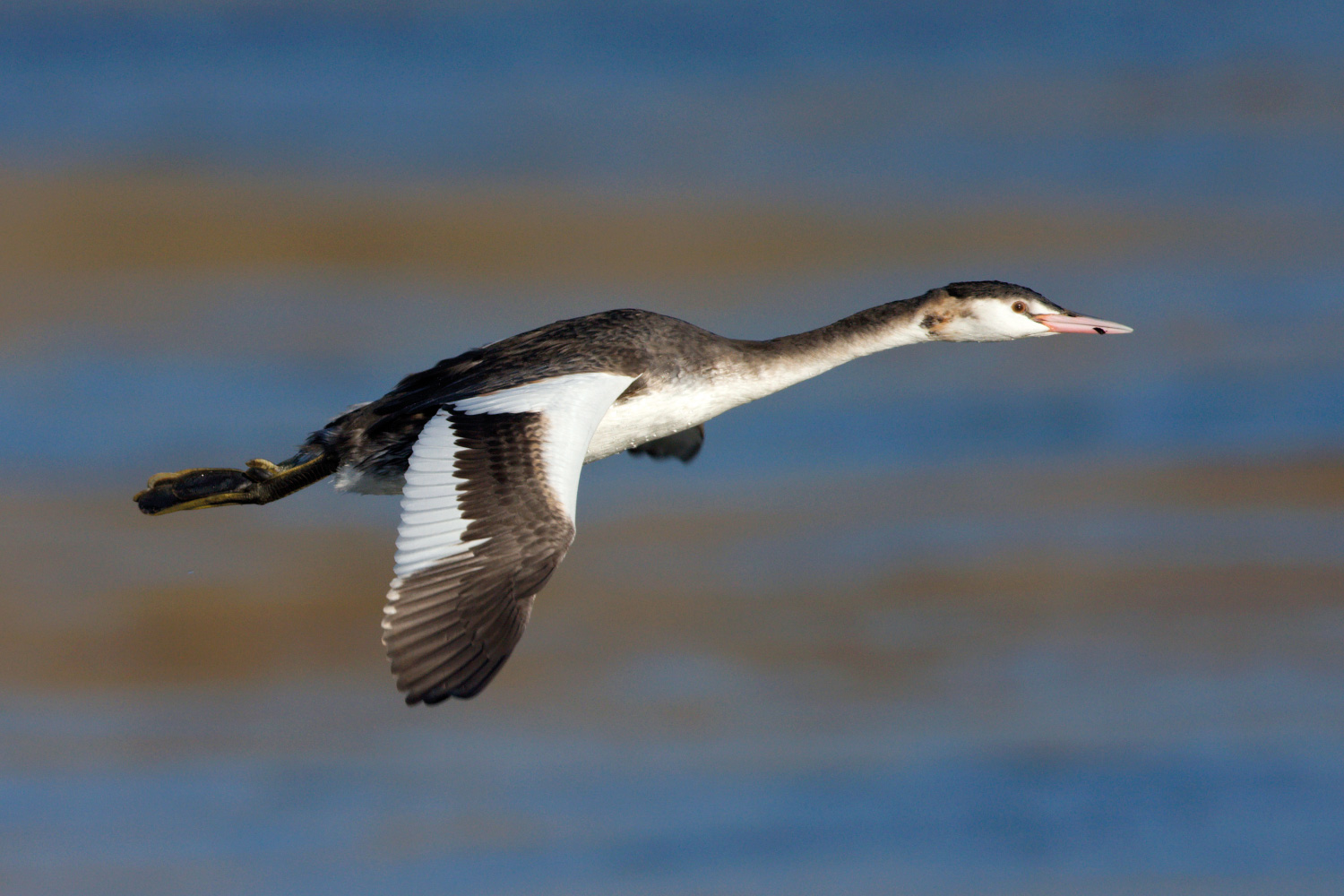
Great Crested Grebe (Grevenbicht, The Netherlands, 16 December 2007). Flying Great Crested Grebes are readily identified by their large size, skinny silhouette and overall whiteness, but they also show very extensive white in the wing as pictured here. Note the extensive white rear-wing patch on the secondaries, while the forewing patch is very extensive too, extending as far as the bend of the wing and also back down the sides of the body, often connecting with the white secondaries (Ran Schols / www.agami.nl).
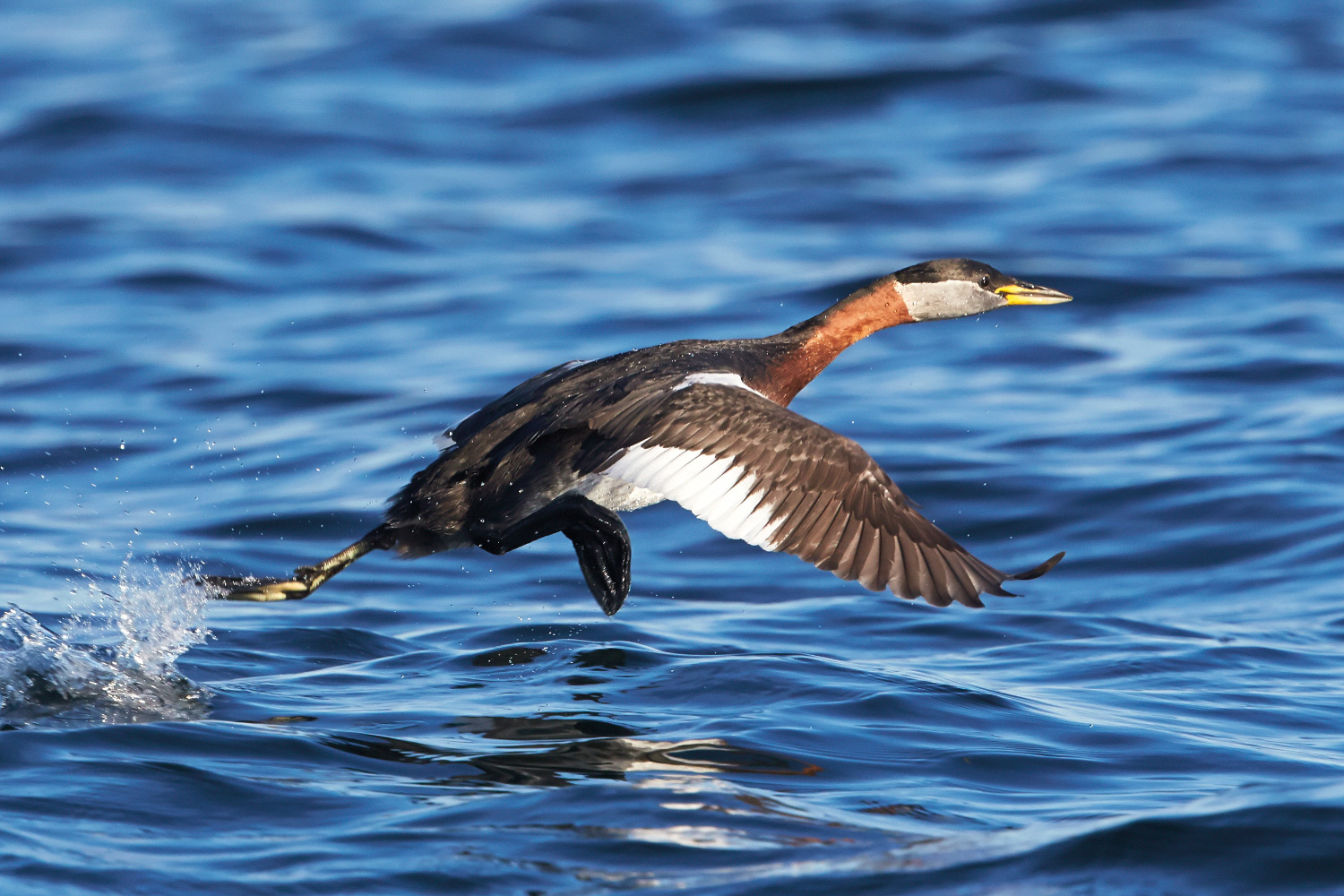
Red-necked Grebe (Finland, 5 August 2015). Though showing a similar pattern to a flying Great Crested Grebe, the forewing patch on this Red-necked Grebe is much smaller, recalling that of a Slavonian Grebe. The white patch on the secondaries is broad and prominent, however. The combination of less white in the forewing and darker body plumage results in a less strikingly black-and-white appearance on the wing than Great Crested (Tomi Muukkonen / www.agami.nl).
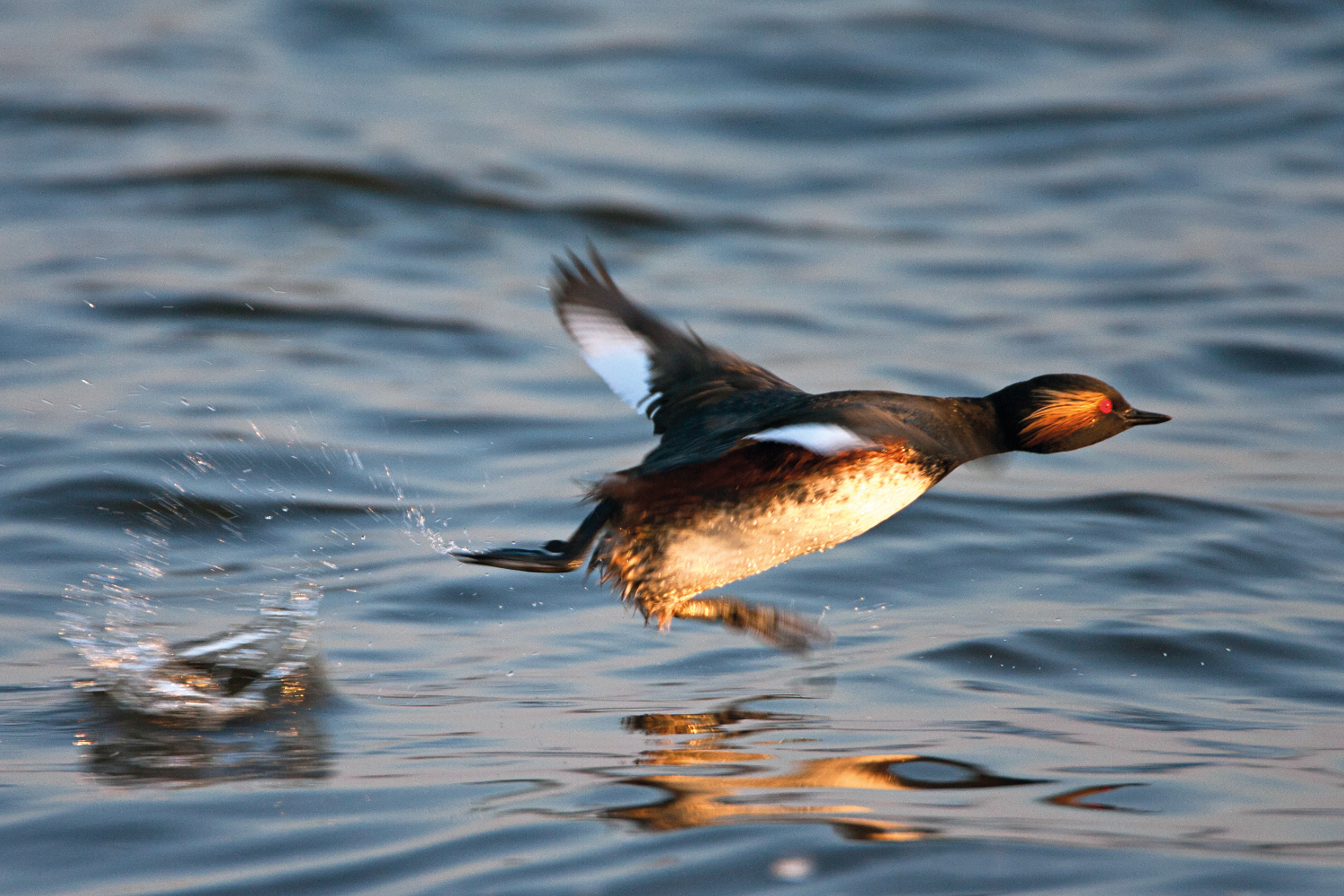
Black-necked Grebe (Starrevaart, The Netherlands, 1 April 2007). In contrast to Slavonian Grebe, this flying Black-necked Grebe shows a larger and more diffuse white patch on the rear of the wing, which extends from the secondaries onto the inner primaries. Note also that the inner forewing is wholly dark, lacking any discrete white patch (Marc Guyt / www.agami.nl).
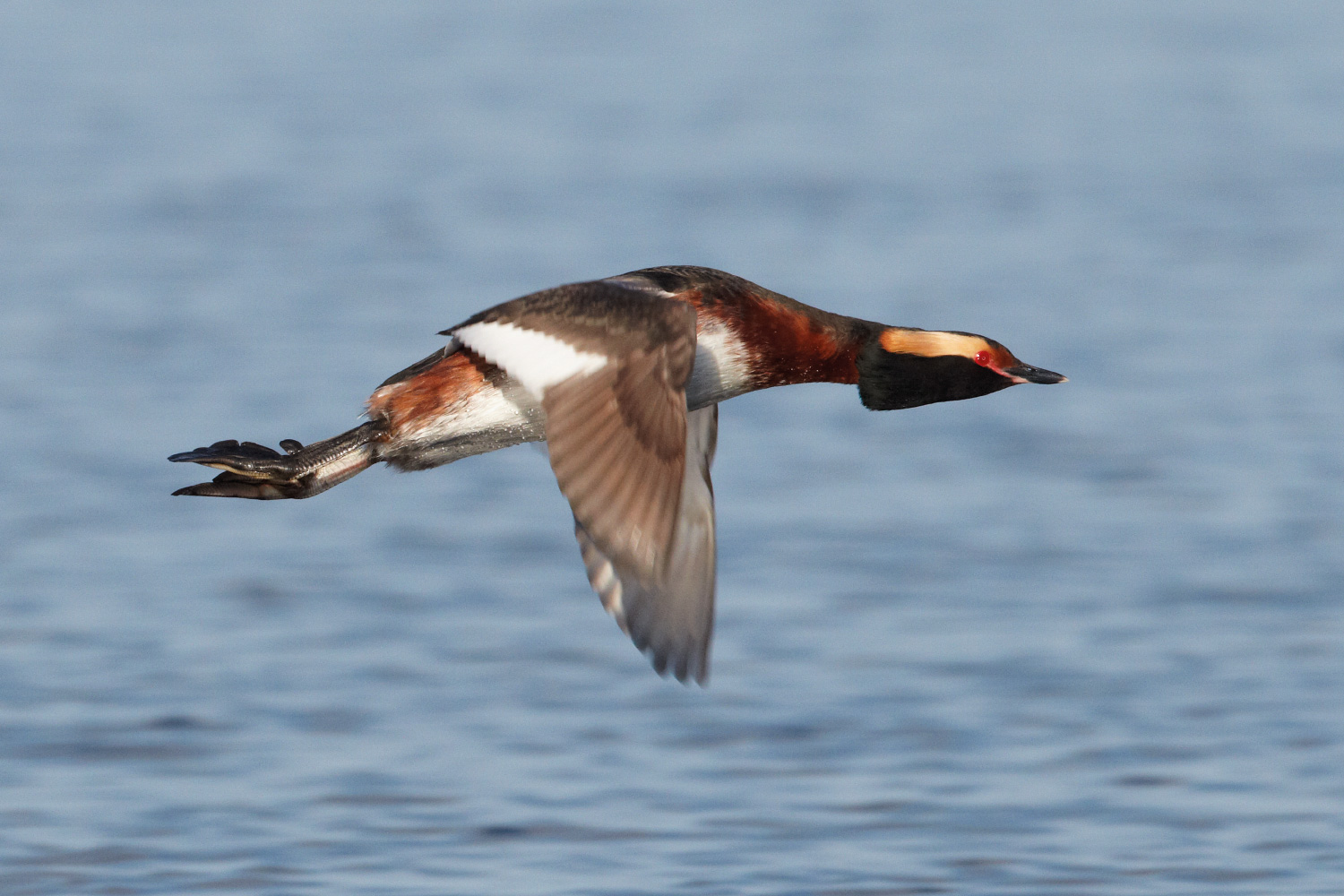
Slavonian Grebe (Utö, Finland, 5 May 2010). Grebes look weak flyers but are capable of surprising movements. Most sightings of flying grebes will be over the sea and involve non-breeding plumage birds so the view here is atypical for Britain. Nevertheless, focus on the wing pattern of this Slavonian Grebe which shows a neatly defined white patch on the secondaries and, just visible, a small white patch on the inner part of the leading edge of the wing – although this latter patch is not shown by juveniles (Markus Varesvuo / www.birdphoto.fi).
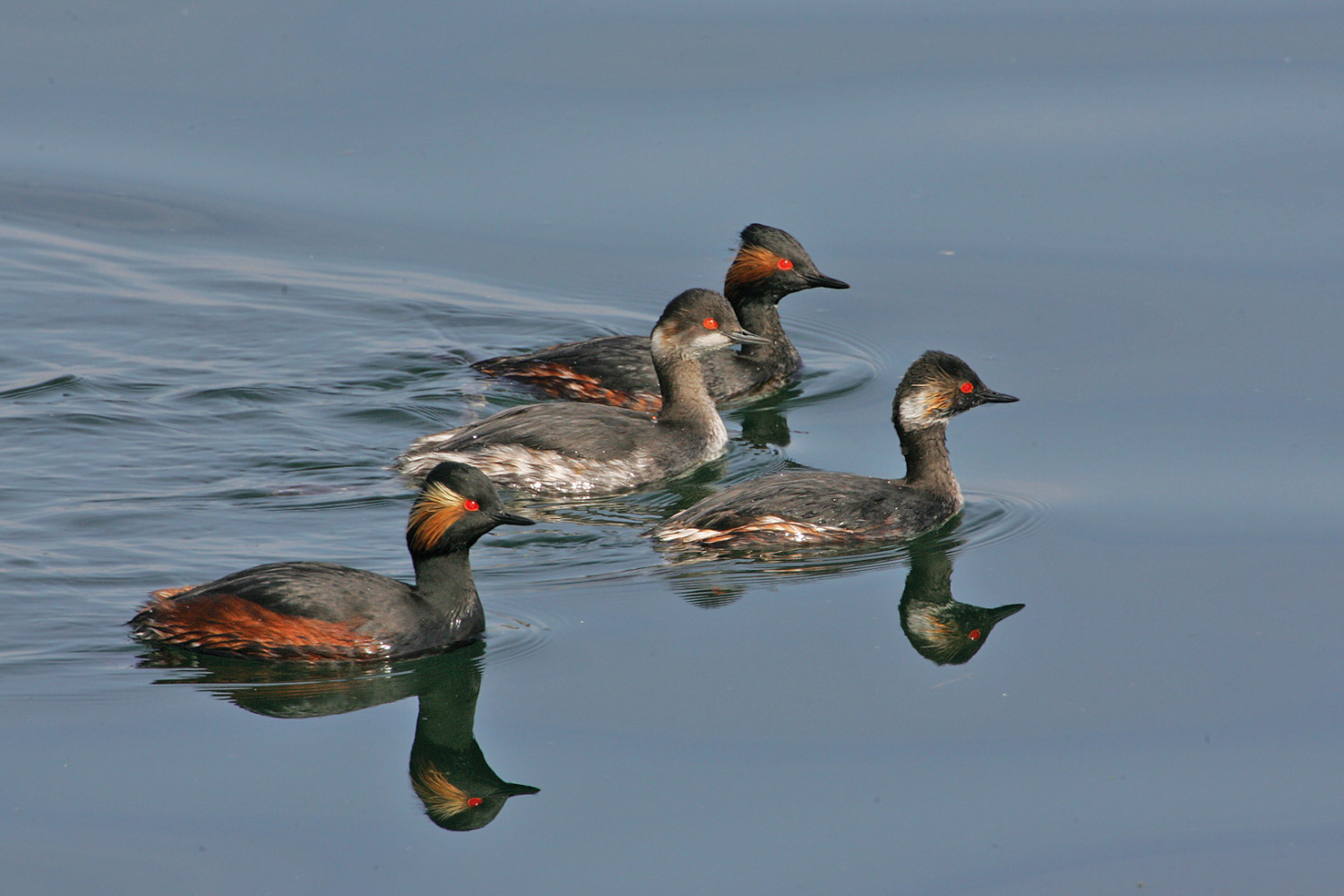
Black-necked Grebes (Extremadura, Spain, 16 March 2005). This delightful group portrait shows Black-necked Grebes in both summer- and winter-type plumages, a combination also possible in Britain in early spring. At such close range, the structural and plumage features are easy to see, but look how prominent the amazing red eyes are (Bill Baston).
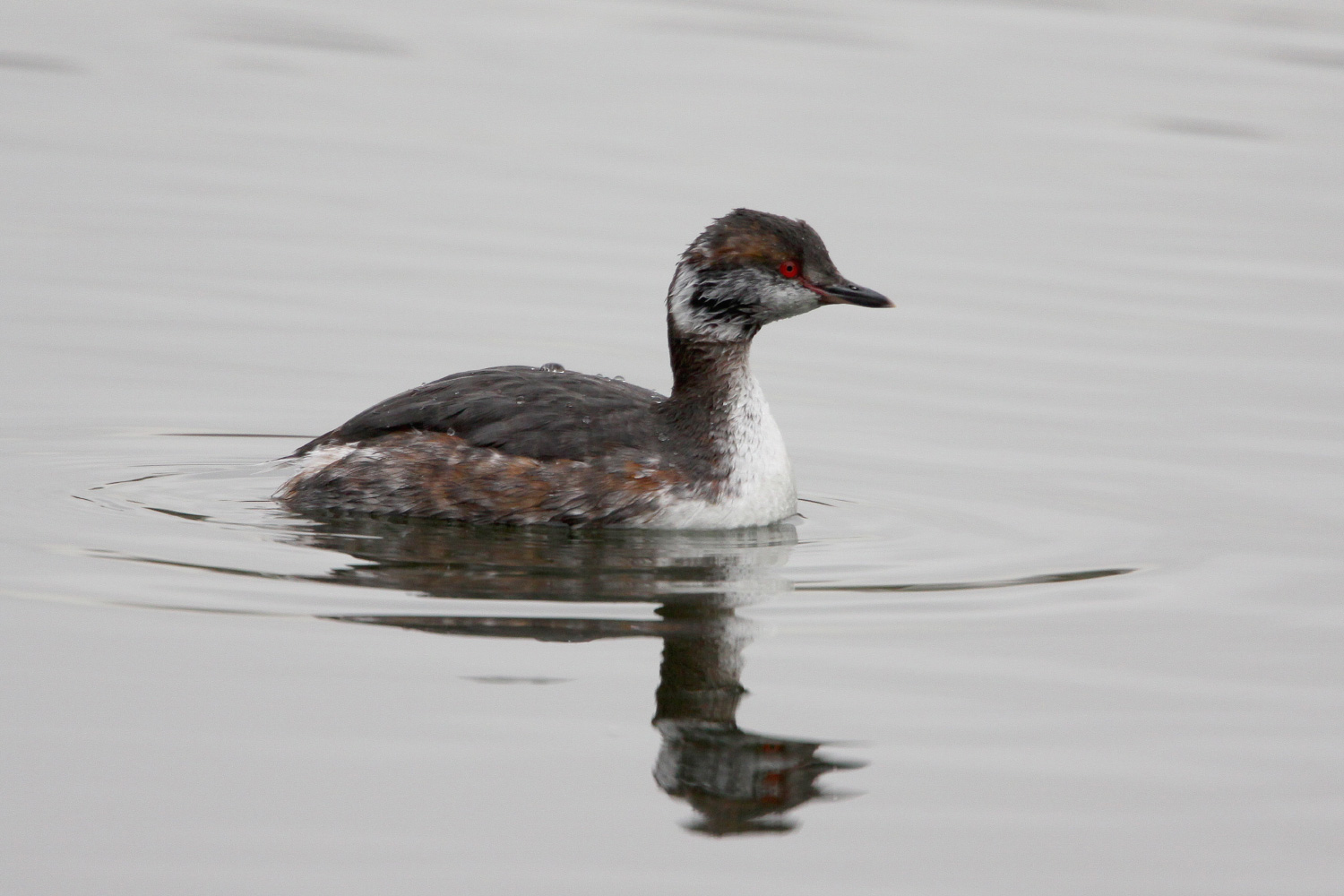
Slavonian Grebe (Alexandra Park, London, 12 April 2013). Though the summer and winter plumages of grebes are highly distinct, there is inevitably a transition period while the moult from one plumage type to the other takes place. This can result in an unfamiliar appearance and, particularly at range, can cause problems. This spring Slavonian Grebe is losing its monochrome winter plumage and acquiring its more rusty summer hues (Dominic Mitchell / www.birdingetc.com).
- This article was originally published in the November 2017 issue of Birdwatch magazine.






